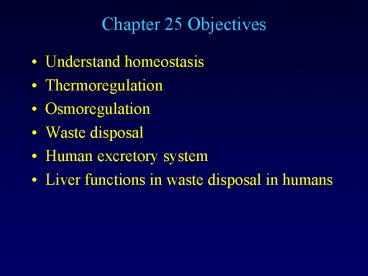Chapter 25 Objectives - PowerPoint PPT Presentation
1 / 21
Title:
Chapter 25 Objectives
Description:
Heat moves from hot areas to cold areas. Animals can adjust body temperature. Involves: ... Countercurrent heat exchanger. Thermoregulation ... – PowerPoint PPT presentation
Number of Views:21
Avg rating:3.0/5.0
Title: Chapter 25 Objectives
1
Chapter 25 Objectives
- Understand homeostasis
- Thermoregulation
- Osmoregulation
- Waste disposal
- Human excretory system
- Liver functions in waste disposal in humans
2
Homeostasis
- Steady-state control mechanisms
- Only allow a narrow range of fluctuations in body
conditions. - Temperature thermoregulation
- Water balance osmoregulation
- Nitrogen wastes excretion
3
Thermoregulation
- Heat moves from hot areas to cold areas
- Animals can adjust body temperature
- Involves
- Heat production
- Heat loss
- Heat gain
4
Thermoregulation fig 25.1
- Conduction
- Gain and loss
- Direct from solid surface
- Convection
- Gain and loss
- Direct from liquid or air
- Radiation
- Usually gain
- Not direct
- Evaporation
- Loss only
- Indirect from liquid to gas exchange
5
Specific Examples of Thermoregulation
- Thermogenesis
- Shivering
- Non-shivering
- Sweating
- Insulation
- Fat, fur, or feathers
- Blood flow
- Dilation/Constriction
- Countercurrent heat exchanger
6
Thermoregulation
- Behavior can be used to regulate body temperature
- Relocation
- Migration
- Bathing, wallowing etc.
- Respiration
7
Thermoregulation
- Animals can change their metabolic rates
- Ectotherms can just allow themselves to freeze
- Low energy requirements?basically zero metabolism
- Require glycerol to prevent water crystallization
- Endotherms need to maintain a higher body
temperature that requires more energy - Torpor
- Hibernation
- Estivation
8
Osmoregulation
- Metabolism depends on a precise balance of
- Water
- Dissolved ions
- Unequal solute concentrations osmosis or
diffusion - Cells cannot survive a net water loss or gain
9
Osmoregulation
- Terrestrial animals are constantly losing water
through evaporation and excretion - Aquatic animals are exposed to continuous osmosis
- Osmoconformer vs. osmoregulator
- Salt water vs. fresh
10
Osmoregulation
- Terrestrial animals cannot exchange materials
directly with the environment - Gain water by eating and drinking
- Land animals face a risk of dehydration
- Water-proof covering
- Reproductive system
- Excretory system that conserves water
11
Osmoregulation
- Sweating is used for thermoregulation
- Can be a problem for water loss
- Salt loss can also cause problems, but usually
not - Drinking water is best when youre sweating
12
Seasonal Dehydration
- Seasonal environments often go from very wet to
dry - Some animals can lose large amounts of water and
go dormant - Water loss should damage proteins and cell
membranes - Use sugars to replace water
13
Waste Disposal fig 25.8
- Metabolism produces toxic by-products
- Nitrogenous wastes
- Excreted wastes variesbetween species
- Amino groups formammonia
- Aquatic animals
- Ammonia excretion
- Diffusion with no energy
14
Waste Disposal fig 25.8
- Terrestrial animals convert ammonia to less toxic
products - Can be stored in the body
- Requires energy
- Urea
- Water soluble
- Uric acid
- Crystal
- More energy
15
Waste Disposal
- Kidneys
- 80 km of tubules
- Network of capillaries
- Filters 1100-1200 L per day
- Produce 180 L of filtrate per day
- Water, urea, ions, glucose, amino acids
- Refine the filtrate
- Excrete about 1.5 L of urine
16
Kidneys fig 25.9
17
Kidneys fig 25.9
- Glomerulus
- Blood pressure forces filtrate into glomerulus
- Nephron tubule refines the filtrate
- Proximal tubule
- Loop of Henle
- Distal tubule
- Collecting duct
18
Nephron Function fig 25.10
- Filtration
- Reabsorption
- Secretion
- Excretion
19
Blood Filtration fig 25.11
- Concentration gradient in the medulla
- Active passive transport secretion
20
Nephrons
- Nephrons conserve water
- Also maintain a tight balance of water and
solutes - Antidiuretic hormone (ADH)
- Tells nephrons to absorb more water
21
Liver Functions
- Prepares nitrogenous wastes for disposal
- Synthesizes urea from ammonia
- Helps kidney get rid of other toxins
- Hepatic portal system
- Glycogen































